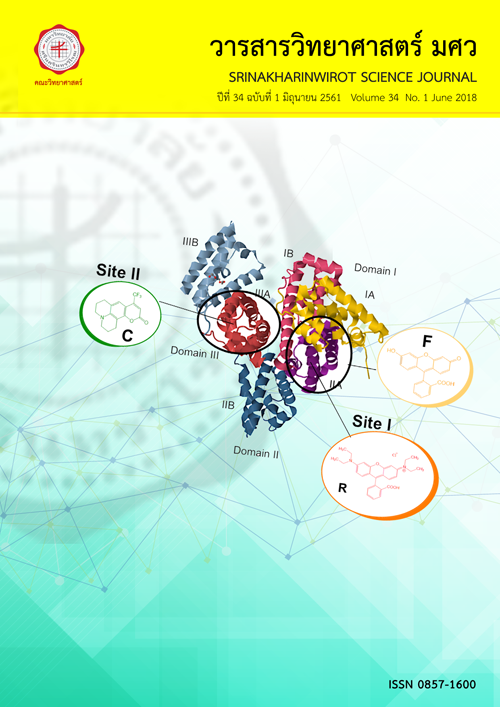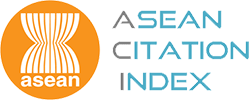การศึกษาเบื้องต้นของเชื้อแลคโตบาซิลลัสสายพันธุ์ไทยที่มีฤทธิ์ยับยั้งการเจริญของเชื้อก่อโรคในลําไส้
Keywords:
Lactobacillus, antibacterial activity, synergistic activity, enteric pathogensAbstract
บทคัดย่อ งานวิจัยนี้มีวัตถุประสงค์เพื่อศึกษาฤทธิ์ต้านเชื้อของแลคโตบาซิลลัสสายพันธุ์ไทยจำนวน 227 ไอโซเลตต่อเชื้อก่อโรคในลำไส้ในหลอดทดลอง แลคโตบาซิลลัสถูกจุด (spot) ลงบนอาหารเลี้ยงเชื้อ Brain Heart Infusion agar ที่มีการเติม 20 mM กลูโคส และเททับ (overlay) ด้วยเชื้อก่อโรคในลำไส้ ผลการศึกษาพบว่าแลคโตบาซิลลัสจำนวน 78 ไอโซเลตจาก 227 ไอโซเลตสามารถยับยั้งเชื้อ Shigella flexneri หรือ Vibrio cholerae แลคโตบาซิลลัสทุกไอโซเลตไม่สามารถยับยั้งเชื้อ Salmonella enterica Typhimurium, enterohemorrhagic Escherichia coli (EHEC), enteroinvasive E. coli (EIEC), enteropathogenic E. coli (EPEC), enterotoxigenic E. coli (ETEC) และสายพันธุ์ E. coli ที่เป็นเชื้อประจำถิ่น/ไม่ก่อโรค เป็นที่น่าสนใจว่าเมื่อจุดเชื้อ L. fermentum B66 อยู่จุดเดียว เชื้อจะไม่สามารถยับยั้ง S. flexneri และ V. cholerae ได้ แต่เมื่อจุดร่วมกับ L. gasseri B49, L. plantarum B64, L. plantarum B67 และ L. mucosae B79 เชื้อจะแสดงคุณสมบัติการเสริมฤทธิ์ซึ่งสามารถยับยั้งเชื้อก่อโรคได้ ยิ่งไปกว่านั้น L. salivarius T38 และ L. salivarius T70 เมื่อจุดร่วมกับ L. casei T20, L. fermentum T37, L. salivarius T39, L. mucosae T78 และ L. reuteri T36, L. salivarius T69, L. salivarius T71, L. mucosae T102 ตามลำดับ สามารถแสดงให้เห็นถึงขนาดของบริเวณใสที่ใหญ่กว่าในการยับยั้งเชื้อ S. flexneri และ V. cholerae เมื่อเทียบกับการจุดแลคโตบาซิลลัสเป็นเชื้อเดี่ยว อย่างไรก็ตาม เมื่อนําอาหารเหลวที่ผ่านการเลี้ยงเชื้อแลคโตบาซิลลัสมาทําให้เข้มข้นแล้วพบว่าไม่มีฤทธิ์ยับยั้งเชื้อก่อโรค โดยสรุป การศึกษานี้แสดงให้เห็นถึงแลคโตบาซิลลัสสายพันธุ์ไทยที่มีฤทธิ์ต้านและการเสริมฤทธิ์สามารถเพิ่มความสามารถในการยับยั้งเชื้อก่อโรคในลำไส้ซึ่งเป็นสาเหตุของโรคอุจจาระร่วงได้ เนื่องจากแลคโตบาซิลลัสไม่ได้มีการยับยั้ง E. coli ที่เป็นเชื้อประจำถิ่น ดังนั้น เชื้อแลคโตบาซิลลัสเหล่านี้จึงมีศักยภาพเป็นโพรไบโอติกป้องกันการติดเชื้อ S. flexneri หรือ V. cholerae ในลําไส้ได้ - - - Preliminary study of antibacterial activity of Lactobacillus Thai isolates against enteric pathogensABSTRACT The objective of this study was to determine the antibacterial activity of 227 Lactobacillus Thai isolates against various enteric pathogens in vitro. Lactobacillus spp. were spotted on Brain Heart Infusion agar supplemented with 20mM glucose and overlaid by enteric pathogens. Seventy-eight of 227 isolates inhibited Shigella flexneri or Vibrio cholerae. All of the Lactobacillus isolates did not inhibit Salmonella enterica Typhimurium, enterohemorrhagic Escherichia coli (EHEC), enteroinvasive E. coli (EIEC), enteropathogenic E. coli (EPEC), enterotoxigenic E. coli (ETEC), and commensal/non-pathogenic E. coli. Interestingly, L. fermentum B66 alone did not inhibit S. flexneri and V. cholerae, but when spotted in conjunction with L. gasseri B49, L. plantarum B64, L. plantarum B67, and L. mucosae B79, it acquired the synergistic activity to inhibit the pathogens. In addition, L. salivarius T38 and L. salivarius T70 when spotted in conjunction with L. casei T20, L. fermentum T37, L. salivarius T39, L. mucosae T78, and L. reuteri T36, L. salivarius T69, L. salivarius T71, L. mucosae T102, respectively, indeed showed larger clear zones to S. flexneri and V. cholerae than the spot of each Lactobacillus alone. However, concentrated culture supernatants of these lactobacilli did not inhibit the pathogens. In conclusion, this study demonstrated that the Lactobacillus Thai isolates had both antibacterial and synergistic activities which could enhance the inhibitory effects on the enteric pathogens causing diarrheal disease. Since they did not inhibit commensal E. coli, these lactobacilli could be potential probiotics against S. flexneri or V. cholerae infection.Downloads
Download data is not yet available.
Downloads
Published
2018-06-29
How to Cite
ธีระวรวงศ์ เ. (2018). การศึกษาเบื้องต้นของเชื้อแลคโตบาซิลลัสสายพันธุ์ไทยที่มีฤทธิ์ยับยั้งการเจริญของเชื้อก่อโรคในลําไส้. Science Essence Journal, 34(1), 139–150. Retrieved from https://ejournals.swu.ac.th/index.php/sej/article/view/9430
Issue
Section
Research Article








